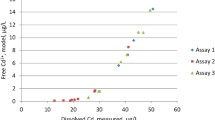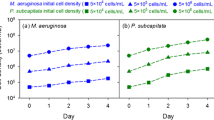Abstract
Acute toxicity tests were conducted to establish the response of Selenastrum capricornutum Printz to sublethal concentrations of As, Cr, Cu, Ni and Zn at a broad range of pH levels. Cultures were incubated for a period of seven days at pH 4 in standard algal assay media containing sublethal concentrations of metals. At this low pH, growth was depressed for all metals tested. The adjustment of pH to higher levels resulted in increased growth when cultures were treated with As, Cu, or Ni and incubated for an additional 7 days. Toxicity was least at the optimum pH range for growth of the alga.
The observation that the toxicity of As, Cu, and Ni to S. capricornutum decreases markedly at pH values above 4.0 may be of ecological importance in the control of acid mine pollution. If a high percentage of algae show a similar response to decreasing toxicity with increasing pH, it clearly would be of value to adopt measures which control pH as well as the levels of metals present. It was suggested that algae with a broad pH growth range, such as S. capricornutum, could benefit from the addition of highly alkaline materials to waters where certain metals are present.
Similar content being viewed by others
References
Antonovics, J., 1971. Heavy metal tolerance in plants. Adv. ecol. Res. 7: 1–85.
Bennett, H. D., 1969. Algae in relation to mine water. Castanea 34: 306–328.
Besch, W. K., M. Richard & R. Castin, 1972. Benthic diatoms as indicators of mining pollution in the Northwest Miramichi River system, New Brunswick, Canada. Int. Revue ges Hydrobiol. 57: 139–174.
Braek, G. S. & A. Jensen, 1976. Heavy metal tolerance of marine phytoplankton. 3. Combined effects of copper and zinc ions on cultures of four common species. J. exp. mar. Biol. Ecol. 25: 37–50.
Cassin, P. E., 1974. Isolation, growth, and physiology of acidophilic chlamydomonads. J. Phycol. 10: 439–447.
Droop, M. R., 1974. Heterotrophy of carbon. In W. D. P. Stewart (ed.), Algal Physiology and Biochemistry, Blackwell Scientific Publications, Oxford: 530–559.
Foster, R. R., 1963. Environmental behavior of chromium and neptunium. In V. Schultz, A. W. Klement Jr. (eds.), Ractio-ecology. Reinhold Publishing Corporation, N.Y.: 569–576.
Gächter, R., K. Lum-Shue-Chan & Y. K. Chau, 1973. Complexing capacity of the nutrient medium and its relation to inhibition of algal photosynthesis by copper. Hydrologie 35: 252–261.
Greeson, P. E., 1982. An annotated key to the identification of commonly occurring and dominant genera of algae observed in the phytoplankton of the United States. Geol. Surv. Wat. Supply, Pap. 2079, U.S. Gov. print. Office, Wash. DC, 46 pp.
Hargreaves, J. W. & B. A. Whitton, 1976. Effect of pH on growth of acid stream algae. Br. Phycol. J. 11: 215–223.
Heaton, R. C., L. E. Wangen, P. L. Wanek, J. M. Williams, E. F. Thode, M. M. Jones, A. M. Nyitray, P. Wagoner & J. P. Bertino, 1982. Trace element characterization of coal wastes. 5th annu. Prog. Rep., Project Summ. U.S. envir. Prot. Ag., Cincinnati, Ohio: 1–6.
Hutchinson, T. C., 1973. Comparative studies of the toxicity of heavy metals to phytoplankton and their synergistic interactions. Wat. Poll. Res. Can. 8: 68–74.
Hutchinson, T. C. & P. M. Stokes, 1975. Heavy metal toxicity and algal bioassays. In Water Quality Parameters. ASTM STP 573, Am. Soc. Test. Mater: 320–343.
Irgolic, K. J., E. A. Woolson, R. A. Stockton, R. D. Newman, N. R. Bottino, R. A. Zigaro, P. C. Kearney, R. A. Pyles, S. Maeda, W. J. McShane & E. R. Cox, 1977. Characterization of arsenic compounds formed by Daphnia magna and Tetraselmis chuii from inorganic arsenate. Envir. Hlth. Perspectives 19: 61–66.
Jenkins, D. W., 1981. Biological monitoring of toxic trace elements. U.S. envir. Prot. Ag., Cincinnati, Ohio: 1–10.
Koelling, J. J., 1971. Relationship of trace elements to algae growth. Ph.D. Diss., Wash. St. Univ. Pullman, Wash. 28: 142.
Macias, R. R. M., 1965. Effect of pH of the medium on the availability of chelated iron for Chlamydomonas mundans. J. Protozool. 12: 500–504.
McDonald, D. G. & A. F. Grandt, 1981. Limestone-lime treatment of acid mine drainage—Full scale. U.S. envir. Prot. Ag. Cincinnati, Ohio: 1–3.
Miller, W. E., J. C. Greene, E. A. Merwen & T. Shiroyama, 1978. Algal bioassay techniques for pollution evaluation. In Toxic materials in the aquatic environment seminar. Oregon St. Univ., Wat. Res. Inst., Corrallis, Oregon: 6–9.
Moss, B., 1973. The influence of environmental factors on the distribution of freshwater algae: an experimental study. 2. The role of pH and carbon dioxide-bicarbonate system. J. Ecol. 61: 157–177.
Nelson, C., 1980. Coal dredging on the Guyandotte River, West Virginia — observations and recommendations. U.S. Army Engineers Rep., U.S. Army Engineers Dist., Huntington, West Virginia. 40 pp.
Peavy, H. S., 1981. Water pollution potential of coal-slurry pipelines. U.S. envir. Prot. Ag., Cincinnati, Ohio: 1–4.
Rodhe, W., 1978. Algae in culture and nature. Mitt. Int. Ver. Limnol. 21: 7–20.
Steemann-Nielsen, E. & L. Kamp-Nielsen, 1970. Influence of deleterious concentrations of copper on the growth of Chlorella pyrenoidosa. Physiol. Pl. 23: 828–840.
Stokes, P. M., 1981. Multiple metal tolerance in copper tolerant green algae. J. Pl. Nutr. 3: 667–678.
Stokes, P. M., T. C. Hutchinson & K. Krauter, 1973. Heavy metal tolerance in algae isolated from contaminated lakes near Sudbury, Ontario. Can. J. Bot. 51: 2155–2168.
Stumm, W., 1972. Die Rolle der Komplexbildung in natürlichen Gewässern und allgällige Beziehungen zur Eutrophierung Gewässerschutz Wass. Abwass. 8: 57–87.
Trollope, D. R. & B. Evans, 1976. Concentrations of copper, iron, nickel and zinc in freshwater algal bloom. Envir. Pollut. 11: 109–116.
U.S. Environmental Protection Agency, 1971. Algal assay procedure bottle test. Nat. Eutrophication Res. Pro., Corvallis, Oregon, 82 pp.
Weaks, T. E., 1982. A step-wise discriminant analysis of the effects of long term coal mine drainage and coal dredging on phytoplankton of the Guyandotte River. Hydrobiologia 97: 97–103.
Wong, S. L. & J. L. Beaver, 1980. Algal bioassays to determine toxicity of metal mixtures. Hydrobiologia 74: 199–208.
Author information
Authors and Affiliations
Rights and permissions
About this article
Cite this article
Michnowicz, C.J., Weaks, T.E. Effects of pH on toxicity of As, Cr, Cu, Ni and Zn to Selenastrum capricornutum Printz. Hydrobiologia 118, 299–305 (1984). https://doi.org/10.1007/BF00046627
Received:
Revised:
Accepted:
Issue Date:
DOI: https://doi.org/10.1007/BF00046627




